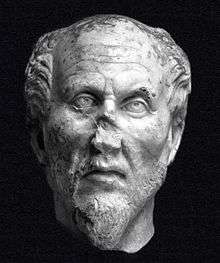De divisione naturae
De divisione naturae ("The division of nature") is the title given by Thomas Gale to his edition (1681) of the work originally titled by Eriugena Periphyseon. This work was the magnum opus of ninth century theologian Johannes Scotus Eriugena.[1]
The work is arranged in five books. The form of exposition is that of dialogue; the method of reasoning is the syllogism. Natura is the name for the universal, the totality of all things, containing in itself being and non-being. It is the unity of which all special phenomena are manifestations. But of this nature there are four distinct classes:
- That which creates and is not created;
- That which is created and creates;
- That which is created and does not create;
- That which neither is created nor creates.
The first is God as the ground or origin of all things, the last is God as the final end or goal of all things, that into which the world of created things ultimately returns. The second and third together compose the created universe, which is the manifestation of God, God in process, Theophania; the second being the world of Platonic ideas or forms, and the third being a more panentheistic, pandeistic, or panendeistic world, depending on the post-creation scope and interference of God.
Thus we distinguish in the divine system beginning, middle and end; but these three are in essence one; the difference is only the consequence of our finite comprehension. We are compelled to envisage this eternal process under the form of time, to apply temporal distinctions to that which is extra- or supra-temporal.
The work was probably carried out beginning in the early 860s and completed around 866–67. This is based on a dedication in the book identifying as frater (brother) Wulfad, who was made a bishop in 866, making it unlikely that Eriugena would have used so casual a reference after that elevation. The work was not widely circulated in the author's lifetime. Eriugena was assisted by one, possibly two other persons in writing the book, based on the presence of margin notes indicating the penmanship of two separate persons. One of these is believed to have been Eriugena himself, while the other was the script indicates that the second writer was a fellow Irishman.
De divisione naturae was condemned by a council at Sens by Honorius III (1225), who described it as "swarming with worms of heretical perversity," and by Pope Gregory XIII in 1585. In 1681, the long-lost work was found at Oxford University, and was immediately placed on the 'Index of Forbidden Books', a turn of events which likely actually spurred its popularity. Despite this result, the Catholic Encyclopedia noted of Eriugena that "there can be no doubt that he himself abhorred heresy, was disposed to treat the heretic with no small degree of harshness..., and all through his life believed himself an unswervingly loyal son of the Church."
The Division of Nature has been called the final achievement of ancient philosophy, a work which "synthesizes the philosophical accomplishments of fifteen centuries." It is presented, like Alcuin's book, as a dialogue between Master and Pupil. Eriugena anticipates Thomas Aquinas, who said that one cannot know and believe a thing at the same time. Eriugena explains that reason is necessary to understand and interpret revelation. "Authority is the source of knowledge", but the reason of mankind is the norm by which all authority is judged.[1]
Notes
External links
- Digitized Latin version on Google Books
- Moran, Dermot. "John Scottus Eriugena". Stanford Encyclopedia of Philosophy.
- Eriugena: Dialectic and Ontology in the Periphyseon
- Eriugena, Periphyseon Book I: Aristotelian Logic and Categories
- Complete List of the Editions and Translations of the Works of Eriugena
- Annotated bibliography on Eriugena's philosophical work
- John Scottus Eriugena: Life and Works
- Johannes Scottus Eriugena: Periphyseon The new critical edition by E. Jeauneau
